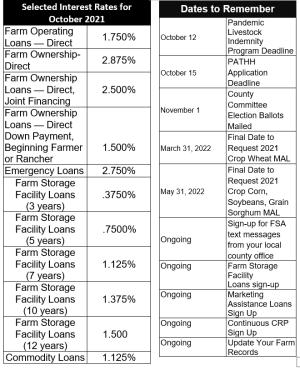|
 County committee members are an important
component of the operations of FSA and provide a link between
the agricultural community and USDA. Farmers and ranchers
elected to county committees help deliver FSA programs at the
local level, applying their knowledge and judgment to make
decisions on commodity price support programs; conservation
programs; incentive indemnity and disaster programs for some
commodities; emergency programs and eligibility. FSA committees
operate within official regulations designed to carry out
federal laws. County committee members are an important
component of the operations of FSA and provide a link between
the agricultural community and USDA. Farmers and ranchers
elected to county committees help deliver FSA programs at the
local level, applying their knowledge and judgment to make
decisions on commodity price support programs; conservation
programs; incentive indemnity and disaster programs for some
commodities; emergency programs and eligibility. FSA committees
operate within official regulations designed to carry out
federal laws.
To be an eligible voter, farmers and ranchers must participate
or cooperate in an FSA program. A person who is not of legal
voting age but supervises and conducts the farming operations of
an entire farm, may also be eligible to vote. A cooperating
producer is someone who has provided information about their
farming or ranching operation(s) but may not have applied or
received FSA program benefits.
Eligible voters in the local administrative area holding a 2021
election who do not receive a ballot can obtain one from their
local USDA Service Center.
Newly elected committee members will take office January 1,
2022.
More information on county committees, such as the new 2021 fact
sheet, can be found on the FSA website at fsa.usda.gov/elections
or at a local USDA Service Center.
USDA Introduces New Insurance Policy for
Farmers Who Sell Locally

The U.S. Department of Agriculture (USDA) is rolling out a new
insurance option specifically for agricultural producers with
small farms who sell locally. The new Micro Farm policy
simplifies record keeping and covers post-production costs like
washing and value-added products.
USDA’s Risk Management Agency (RMA) created this new policy
based on research directed by the 2018 Farm Bill, and it
includes feedback from producers who grow for their local
communities. The policy will be available beginning with the
2022 crop year.
“We are excited to offer this new coverage for producers who
work to provide their communities with fresh and healthy food,”
said RMA Acting Administrator Richard Flournoy. “USDA is focused
on supporting local and regional food systems, and this new crop
insurance policy is designed with this important sector of
agriculture in mind.”
The new policy is offered through Whole-Farm Revenue Protection
(WFRP) and it has distinct provisions that can provide more
access to the program, including:
No expense or individual commodity reporting needed, simplifying
the recordkeeping requirements for producers
Revenue from post-production costs, such as washing and
packaging commodities and value-added products, are considered
allowable revenue. The Micro Farm policy builds on other RMA
efforts to better serve specialty and organic crop growers. This
includes WFRP, which provides coverage for producers with larger
operations that may not be eligible for Micro Farm. RMA recently
made improvements to WFRP as part of a broader set of new
policies and expanded policies to assist specialty crop and
organic producers.
USDA touches the lives of all Americans each day in so many
positive ways. In the Biden-Harris Administration, USDA is
transforming America’s food system with a greater focus on more
resilient local and regional food production, fairer markets for
all producers, ensuring access to healthy and nutritious food in
all communities, building new markets and streams of income for
farmers and producers using climate smart food and forestry
practices, making historic investments in infrastructure and
clean energy capabilities in rural America, and committing to
equity across the Department by removing systemic barriers and
building a workforce more representative of America. To learn
more, visit www.usda.gov.

The Federal Crop Insurance Corporation approved the Micro Farm
policy in late September, and additional details will be
provided later this fall.
The Micro Farm policy is available to producers who have a farm
operation that earns an average allowable revenue of $100,000 or
less, or for carryover insureds, an average allowable revenue of
$125,000 or less. RMA’s research showed that 85% of producers
who sell locally reported they made less than $75,000 in gross
sales. See the full report.
The Micro Farm policy builds on other RMA
efforts to better serve specialty and organic crop growers. This
includes WFRP, which provides coverage for producers with larger
operations that may not be eligible for Micro Farm. RMA recently
made improvements to WFRP as part of a broader set of new
policies and expanded policies to assist specialty crop and
organic producers.
The Federal Crop Insurance Corporation approved the Micro Farm
policy in late September, and additional details will be
provided later this fall.
More Information
Crop insurance is sold and delivered solely through private crop
insurance agents. A list of crop insurance agents is available
at all USDA Service Centers and online at the RMA Agent Locator.
Learn more about crop insurance and the modern farm safety net
at rma.usda.gov.
USDA touches the lives of all Americans each day in so many
positive ways. In the Biden-Harris Administration, USDA is
transforming America’s food system with a greater focus on more
resilient local and regional food production, fairer markets for
all producers, ensuring access to healthy and nutritious food in
all communities, building new markets and streams of income for
farmers and producers using climate smart food and forestry
practices, making historic investments in infrastructure and
clean energy capabilities in rural America, and committing to
equity across the Department by removing systemic barriers and
building a workforce more representative of America. To learn
more, visit www.usda.gov.
FSA Outlines MAL and LDP Policy
The 2018 Farm Bill extends loan authority
through 2023 for Marketing Assistance Loans (MALs) and Loan
Deficiency Payments (LDPs).

MALs and LDPs provide financing and marketing assistance for
wheat, feed grains, soybeans, and other oilseeds, pulse crops,
rice, peanuts, cotton, wool and honey. MALs provide you with
interim financing after harvest to help you meet cash flow needs
without having to sell your commodities when market prices are
typically at harvest-time lows. A producer who is eligible to
obtain a loan, but agrees to forgo the loan, may obtain an LDP
if such a payment is available. Marketing loan provisions and
LDPs are not available for sugar and extra-long staple cotton.
FSA is now accepting requests for 2021 MALs and LDPs for all
eligible commodities after harvest. Requests for loans and LDPs
shall be made on or before the final availability date for the
respective commodities.
Commodity certificates are available to loan holders who have
outstanding nonrecourse loans for wheat, upland cotton, rice,
feed grains, pulse crops (dry peas, lentils, large and small
chickpeas), peanuts, wool, soybeans and designated minor
oilseeds. These certificates can be purchased at the posted
county price (or adjusted world price or national posted price)
for the quantity of commodity under loan, and must be
immediately exchanged for the collateral, satisfying the loan.
MALs redeemed with commodity certificates are not subject to
Adjusted Gross Income provisions.
To be considered eligible for an LDP, you must have form
CCC-633EZ, Page 1 on file at your local FSA Office before losing
beneficial interest in the crop. Pages 2, 3 or 4 of the form
must be submitted when payment is requested.
Marketing loan gains (MLGs) and loan deficiency payments (LDPs)
are no longer subject to payment limitations, actively engaged
in farming and cash-rent tenant rules.
Adjusted Gross Income (AGI) provisions state that if your total
applicable three-year average AGI exceeds $900,000, then you’re
not eligible to receive an MLG or LDP. You must have a valid
CCC-941 on file to earn a market gain of LDP. The AGI does not
apply to MALs redeemed with commodity certificate exchange.
For more information and additional eligibility requirements,
contact your local County USDA Service Center or visit
fsa.usda.gov.
Farm Storage Facility Loans

FSA’s Farm Storage Facility Loan (FSFL) program
provides low-interest financing to producers to build or upgrade
storage facilities and to purchase portable (new or used)
structures, equipment and storage and handling trucks.
The low-interest funds can be used to build or upgrade permanent
facilities to store commodities. Eligible commodities include
corn, grain sorghum, rice, soybeans, oats, peanuts, wheat,
barley, minor oilseeds harvested as whole grain, pulse crops
(lentils, chickpeas and dry peas), hay, honey, renewable
biomass, fruits, nuts and vegetables for cold storage
facilities, floriculture, hops, maple sap, rye, milk, cheese,
butter, yogurt, meat and poultry (unprocessed), eggs, and
aquaculture (excluding systems that maintain live animals
through uptake and discharge of water). Qualified facilities
include grain bins, hay barns and cold storage facilities for
eligible commodities.
Loans up to $50,000 can be secured by a promissory note/security
agreement and loans between $50,000 and $100,000 may require
additional security. Loans exceeding $100,000 require additional
security.
Producers do not need to demonstrate the lack of commercial
credit availability to apply. The loans are designed to assist a
diverse range of farming operations, including small and
mid-sized businesses, new farmers, operations supplying local
food and farmers markets, non-traditional farm products, and
underserved producers.
To learn more about the FSA Farm Storage Facility Loan, visit
www.fsa.usda.gov/pricesupport or contact your local FSA county
office. To find your local FSA county office, visit
http://offices.usda.gov.
USDA Encourages You to Consider NAP Risk
Protection Coverage Before Crop Sales Deadlines
The Farm Service Agency encourages you to
examine available USDA crop risk protection options, including
federal crop insurance and Noninsured Crop Disaster Assistance
Program (NAP) coverage, before the applicable crop sales
deadline.
Federal crop insurance covers crop losses from natural
adversities such as drought, hail and excessive moisture. NAP
covers losses from natural disasters on crops for which no
permanent federal crop insurance program is available. You can
determine if crops are eligible for federal crop insurance or
NAP by visiting the RMA website.

NAP offers higher levels of coverage, from 50 to 65 percent of
expected production in 5 percent increments, at 100 percent of
the average market price. Producers of organics and crops
marketed directly to consumers also may exercise the “buy-up”
option to obtain NAP coverage of 100 percent of the average
market price at the coverage levels of between 50 and 65 percent
of expected production. Buy-up levels of NAP coverage are
available if the producer can show at least one year of
previously successfully growing the crop for which coverage is
being requested. NAP basic coverage is available at 55 percent
of the average market price for crop losses that exceed 50
percent of expected production.
For all coverage levels, the NAP service fee is the lesser of
$325 per crop or $825 per producer per county, not to exceed a
total of $1,950 for a producer with farming interests in
multiple counties.
Beginning, underserved, veterans and limited resource farmers
are now eligible for free catastrophic level coverage.
Deadlines for coverage vary by state and crop. Contact your
local County USDA Service Center or visit fsa.usda.gov.
Federal crop insurance coverage is sold and delivered solely
through private insurance agents. Agent lists are available at
all USDA Service Centers or at USDA’s online Agent Locator. You
can use the USDA Cost Estimator to predict insurance premium
costs.
Progression Lending from FSA
Farm Service Agency (FSA) farm loans are
considered progression lending. Unlike loans from a commercial
lender, FSA loans are intended to be temporary in nature. Our
goal is to help you graduate to commercial credit, and our farm
loan staff is available to help borrowers through training and
credit counseling.
The FSA team will help borrowers identify their goals to ensure
financial success. FSA staff will advise borrowers on developing
strategies and a plan to meet your goals and graduate to
commercial credit. FSA borrowers are responsible for the success
of their farming operation, but FSA staff will help in an
advisory role, providing the tools necessary to help you achieve
your operational goals and manage your finances.

For more information on FSA farm loan programs, contact your
local County USDA Service Center or visit fsa.usda.gov.
Policy Updating for Acreage Reporting
The USDA Farm Service Agency (FSA) recently
made several policy updates for acreage reporting for cover
crops, revising intended use, late-filed provisions, grazing
allotments as well as updated the definitions of “idle” and
“fallow.”
Reporting Cover Crops:
Cover crop types can be chosen from the following four
categories:
Cereals and other grasses
Legumes
Brassicas and other broadleaves
Mixtures
If the cover crop is harvested for any use other than forage or
grazing and is not terminated according to policy guidelines,
then that crop will no longer be considered a cover crop and the
acreage report must be revised to reflect the actual crop.
Permitted Revision of Intended use After Acreage Reporting
Date:
New operators or owners who pick up a farm after the acreage
reporting deadline has passed and the crop has already been
reported on the farm, have 30 calendar days from the date when
the new operator or owner acquired the lease on land, control of
the land or ownership and new producer crop share interest in
the previously reported crop acreage. Under this policy,
appropriate documentation must be provided to the County
Committee’s satisfaction to determine that a legitimate operator
or ownership and producer crop share interest change occurred to
permit the revision.
Acreage Reports:
In order to maintain program eligibility and benefits, you must
timely file acreage reports. Failure to file an acreage report
by the crop acreage reporting deadline may result in
ineligibility for future program benefits. FSA will not accept
acreage reports provided more than a year after the acreage
reporting deadline.
Reporting Grazing Allotments:
FSA offices can now accept acreage reports for grazing
allotments. You will use form “FSA-578” to report grazing
allotments as animal unit months (AUMs) using the “Reporting
Unit” field. Your local FSA office will need the grazing period
start and end date and the percent of public land.
[to top of second column] |

Definitions of Terms
FSA defines “idle” as cropland or a balance of cropland within a
Common Land Unit (CLU) (field/subfield) which is not planted or
considered not planted and does not meet the definition of fallow or
skip row.
Fallow is considered unplanted cropland acres which are part of a
crop/fallow rotation where cultivated land that is normally planted
is purposely kept out of production during a regular growing season.
For more information, contact your local County USDA Service Center
or visit fsa.usda.gov.
FSA is Accepting CRP Continuous
Enrollment Offers
The Farm Service Agency (FSA) is accepting offers for specific
conservation practices under the Conservation Reserve Program (CRP)
Continuous Signup.
In exchange for a yearly rental payment, farmers enrolled in the
program agree to remove environmentally sensitive land from
agricultural production and to plant species that will improve
environmental health and quality. The program’s long-term goal is to
re-establish valuable land cover to improve water quality, prevent
soil erosion, and reduce loss of wildlife habitat. Contracts for
land enrolled in CRP are 10-15 years in length.
Under continuous CRP signup, environmentally sensitive land devoted
to certain conservation practices can be enrolled in CRP at any
time. Offers for continuous enrollment are not subject to
competitive bidding during specific periods. Instead, they are
automatically accepted provided the land and producer meet certain
eligibility requirements and the enrollment levels do not exceed the
statutory cap.
For more information, including a list of acceptable practices,
contact your local County USDA Service Center or visit fsa.usda.gov/crp.
Communication is the Key to Lending
Farm Service Agency (FSA) is committed to providing
our farm loan borrowers the tools necessary to be successful. FSA
staff will provide guidance and counsel from the loan application
process through the borrower’s graduation to commercial credit.
While it is FSA’s commitment to advise borrowers as they identify
goals and evaluate progress, it is crucial for borrowers to
communicate with their farm loan staff when changes occur. It is the
borrower’s responsibility to alert FSA to any of the following:
Any proposed or significant changes in the farming operation
Any significant changes to family income or expenses

The development of problem situations
Any losses or proposed significant changes in security
If a farm loan borrower can’t make payments to suppliers, other
creditors, or FSA on time, contact your farm loan staff immediately
to discuss loan servicing options.
For more information on FSA farm loan programs, contact your local
County USDA Service Center or visit fsa.usda.gov.
Applying for NAP Payments
The Noninsured Crop Disaster Assistance Program
(NAP) provides financial assistance to you for crops that aren’t
eligible for crop insurance to protect against lower yields or crops
unable to be planted due to natural disasters including freeze,
hail, excessive moisture, excessive wind or hurricanes, flood,
excessive heat and qualifying drought (includes native grass for
grazing), among others.
In order to participate, you must obtain NAP coverage for the crop
year by the applicable deadline using form CCC-471 “Application for
Coverage” and pay the service fee. Application closing dates vary by
crop. Producers are also required to submit an acceptable crop
acreage report. Additionally, NAP participants must provide:
The quantity of all harvested production of the crop in which the
producer held an interest during the crop year
The disposition of the harvested crop, such as whether it is
marketable, unmarketable, salvaged or used differently than intended
Acceptable crop production records (when requested by FSA)
Producers who fail to report acreage and production information for
NAP-covered crops could see reduced or zero NAP assistance. These
reports are used to calculate the approved yield.
If your NAP-covered crops are affected by a natural disaster, notify
your FSA office by completing Part B of form CCC-576 “Notice of Loss
and Application for Payment.” This must be completed within 15
calendar days of the occurrence of the disaster or when losses
become apparent or 15 days of the final harvest date. For
hand-harvested crops and certain perishable crops, you must notify
FSA within 72 hours of when a loss becomes apparent.

To receive benefits, you must also complete Parts D, E, F and G of
the CCC-576 “Notice of Loss and Application for Payment” within 60
days of the last day of coverage for the crop year for any NAP
covered crops. The CCC-576 requires acceptable appraisal
information. Producers must provide evidence of production and note
whether the crop was marketable, unmarketable, salvaged or used
differently than intended.
Eligible crops must be commercially produced agricultural
commodities for which crop insurance is not available, including
perennial grass forage and grazing crops, fruits, vegetables,
mushrooms, floriculture, ornamental nursery, aquaculture, turf
grass, ginseng, honey, syrup, bioenergy, and industrial crops.
For more information on NAP, contact your local County USDA Service
Center or visit fsa.usda.gov/nap.
Unauthorized Disposition of Grain
If loan grain has been disposed of through feeding, selling or any
other form of disposal without prior written authorization from the
county office staff, it is considered unauthorized disposition. The
financial penalties for unauthorized dispositions are severe and a
producer’s name will be placed on a loan violation list for a
two-year period. Always call before you haul any grain under loan.
Double-Cropping
Each year, state committees review and approve or
disapprove county committee recommended changes or additions to
specific combinations of crops.
Double-cropping is approved when two specific crops have the
capability to be planted and carried to maturity for the intended
use, as reported by the producer, on the same acreage within a crop
year under normal growing conditions. The specific combination of
crops recommended by the county committee must be approved by the
state committee.
Double-cropping is approved in Illinois on a county-by-county basis.
Contact your local FSA Office for a list of approved double-cropping
combinations for your county.
A crop following a cover crop terminated according to termination
guidelines is approved double cropping and these combinations do not
have to be approved by the state committee.

USDA Encourages You to Consider NAP Risk
Protection Coverage Before Crop Sales Deadlines
The Farm Service Agency encourages you to examine
available USDA crop risk protection options, including federal crop
insurance and Noninsured Crop Disaster Assistance Program (NAP)
coverage, before the applicable crop sales deadline.
Federal crop insurance covers crop losses from natural adversities
such as drought, hail and excessive moisture. NAP covers losses from
natural disasters on crops for which no permanent federal crop
insurance program is available. You can determine if crops are
eligible for federal crop insurance or NAP by visiting the RMA
website.
NAP offers higher levels of coverage, from 50 to 65 percent of
expected production in 5 percent increments, at 100 percent of the
average market price. Producers of organics and crops marketed
directly to consumers also may exercise the “buy-up” option to
obtain NAP coverage of 100 percent of the average market price at
the coverage levels of between 50 and 65 percent of expected
production. Buy-up levels of NAP coverage are available if the
producer can show at least one year of previously successfully
growing the crop for which coverage is being requested. NAP basic
coverage is available at 55 percent of the average market price for
crop losses that exceed 50 percent of expected production.
For all coverage levels, the NAP service fee is the lesser of $325
per crop or $825 per producer per county, not to exceed a total of
$1,950 for a producer with farming interests in multiple counties.
Beginning, underserved, veterans and limited resource farmers are
now eligible for free catastrophic level coverage.
Deadlines for coverage vary by state and crop. Contact your local
County USDA Service Center or visit fsa.usda.gov.
Federal crop insurance coverage is sold and delivered solely through
private insurance agents. Agent lists are available at all USDA
Service Centers or at USDA’s online Agent Locator. You can use the
USDA Cost Estimator to predict insurance premium costs.
Obtaining Payments Due to Deceased Producers

In order to claim a Farm Service Agency (FSA)
payment on behalf of a deceased producer, all program conditions for
the payment must have been met before the applicable producer’s date
of death.
If a producer earned a FSA payment prior to his or her death, the
following is the order of precedence for the representatives of the
producer:
administrator or executor of the estate
the surviving spouse
surviving sons and daughters, including adopted children
surviving father and mother
surviving brothers and sisters
heirs of the deceased person who would be entitled to payment
according to the State law
For FSA to release the payment, the legal representative of the
deceased producer must file a form FSA-325 to claim the payment for
themselves or an estate. The county office will verify that the
application, contract, loan agreement, or other similar form
requesting payment issuance, was signed by the applicable deadline
by the deceased or a person legally authorized to act on their
behalf at that time of application.
If the application, contract or loan agreement form was signed by
someone other than the deceased participant, FSA will determine
whether the person submitting the form has the legal authority to
submit the form.
Payments will be issued to the respective representative’s name
using the deceased program participant’s tax identification number.
Payments made to representatives are subject to offset regulations
for debts owed by the deceased.
FSA is not responsible for advising persons in obtaining legal
advice on how to obtain program benefits that may be due to a
participant who has died, disappeared or who has been declared
incompetent.
Environmental Review Required Before Project
Implementation
The National Environmental Policy Act (NEPA)
requires Federal agencies to consider all potential environmental
impacts for federally-funded projects before the project is
approved.

For all Farm Service Agency (FSA) programs, an environmental review
must be completed before actions are approved, such as site
preparation or ground disturbance. These programs include, but are
not limited to, the Emergency Conservation Program (ECP), Farm
Storage Facility Loan (FSFL) program and farm loans. If project
implementation begins before FSA has completed an environmental
review, the request will be denied. Although there are exceptions
regarding the Stafford Act and emergencies, it’s important to wait
until you receive written approval of your project proposal before
starting any actions.
Applications cannot be approved until FSA has copies of all permits
and plans. Contact your local FSA office early in your planning
process to determine what level of environmental review is required
for your program application so that it can be completed timely.
Filing CCC-941 Adjust Gross Income AGI
Certificates
If you have experienced delays in receiving
Agriculture Risk Coverage (ARC) and Price Loss Coverage (PLC)
payments, Loan Deficiency Payments (LDPs) and Market Gains on
Marketing Assistance Loans (MALs), it may be because you have not
filed form CCC-941, Adjusted Gross Income Certification.
If you don’t have a valid CCC-941 on file for the applicable crop
year you will not receive payments. All farm operator/tenants/owners
who have not filed a CCC-941 and have pending payments should
IMMEDIATELY file the form with their recording county FSA office.
Farm operators and tenants are encouraged to ensure that their
landowners have filed the form.
FSA can accept the CCC-941 for 2018, 2019, 2020, 2021, and 2022.
Unlike the past, you must have the CCC-941 certifying your AGI
compliance before any payments can be issued.
Maintaining the Quality of Farm-Stored Loan
Grain
Bins are ideally designed to hold a level volume of
grain. When bins are overfilled and grain is heaped up, airflow is
hindered and the chance of spoilage increases.
Producers who take out marketing assistance loans and use the
farm-stored grain as collateral should remember that they are
responsible for maintaining the quality of the grain through the
term of the loan.

October Interest Rates and Important Dates

["Farmers.gov] |